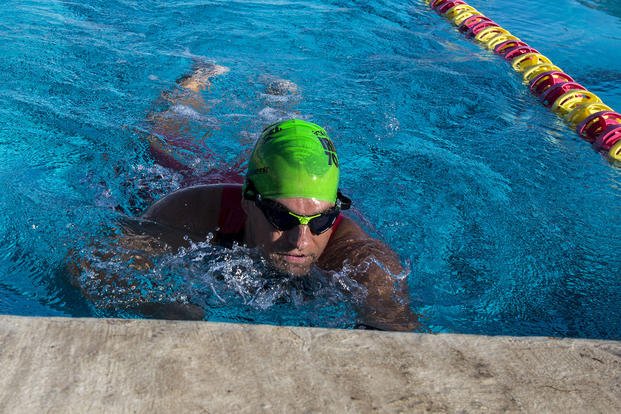If you are bored with counting laps in the pool and want a better way to keep track of time and distance for your swim workouts, try the 1:30 Interval Challenge.
The goal of this workout is to swim either 50, 75 or 100 meters in a timed interval of 1 minute, 30 seconds (1:30). If you swim 50 meters, you likely will have 30-45 seconds of rest every set. If you select the 75-meter option, you should have about 20 seconds of rest, and if you go for 100 meters in the 1:30 set, you may have only 10-15 seconds, depending upon your swimming abilities.
The Challenge
Each month for the next three months, strive to progress to the Century Club. This is a challenge, but the goal is to do what you can and rest as needed within the 1:30 start/stop intervals. If you are a beginner, just try 25 meters and rest until the next start time.
Month One: 50 sets
50 sets of 1:30 = 75 minutes of swimming intervals. If you never have tried swimming more than an hour, build up and do 20 sets x 1:30 for 30 minutes of swimming. Try a few times before going for the 50 sets, and you will find that 75 minutes of swimming with intermittent rests is not that hard.
*Note: Also, if you prefer, you can add a pair of fins and swim faster and maybe push your distance each set.
Typical distances: 50 x 50 meters = 2,500 meters, 50 x 75 meters = 3,750 meters, 50 x 100 meters = 5,000 meters. If you find you want to try to push yourself on a few 100-meter sets, give it a shot, then rest with an easy 50 meters immediately after.
Month 2: 75 sets
75 sets of 1:30 = 112.5 minutes. Now you are looking at almost two hours of swimming. During the first month and first few weeks of the second month, you can practice building up to 75-90 minutes of swimming, then testing yourself one day and push the 75 sets of swimming.
Typical distances: 75 x 50 meters = 3,750 meters, 75 x 75 meters = 5,625 meters, 75 x 100 meters = 7,500 meters. If you find you want to try to push yourself on a few 100-meter sets, give it a shot, then rest with an easy 50 meters immediately after.
Month 3: 100 sets
100 sets of 1:30 = 150 minutes. That is 2.5 hours of swimming. Now you are looking at likely more swimming than you have ever done. During the second month and first few weeks of the third month, you can practice building up to 90-120 minutes of swimming, then testing yourself one day and push the 100 sets of swimming. You can pace yourself, do smaller sets at first and see how long you can last.
Typical distances: 100 x 50 meters = 5,000 meters, 100 x 75 meters = 7,500 meters, 100 x 100 meters = 10,000 meters. If you find you want to try to push yourself on a few 100-meter sets, give it a shot, then rest with an easy 50 meters immediately after.
Recommendation
Anytime you are swimming for longer than an hour, you should have water, electrolytes and some sugar. A Gatorade-type sports drink, along with a bottle of water, typically will be helpful for you to stay in the game and not burn out with the long swim workout.
Stew Smith is a former Navy SEAL and fitness author certified as a Strength and Conditioning Specialist (CSCS) with the National Strength and Conditioning Association. Visit his Fitness eBook store if you're looking to start a workout program to create a healthy lifestyle. Send your fitness questions to stew@stewsmith.com.
Want to Learn More About Military Life?
Whether you're thinking of joining the military, looking for fitness and basic training tips, or keeping up with military life and benefits, Military.com has you covered. Subscribe to Military.com to have military news, updates and resources delivered directly to your inbox.



















